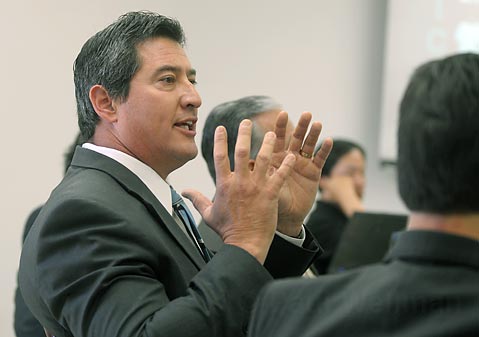Gang Prevention Effort Off to Slow Start
Jobs Programs for At-Risk Youth Show Promise
The red and blue strobe lights atop three police cars and two ambulances strafed the homes of lower Eastside residents living near the alleyway by Canada and Liberty streets late Wednesday night. Nearby residents claimed they saw a sheet-covered body wheeled off on a gurney and driven out in an ambulance. Was this the latest fatality in Santa Barbara’s long simmering gang feud, the beginning of a long hot summer?
Police Sergeant Mike McGrew claimed otherwise, explaining that a juvenile offender who’d escaped from Los Prietos Boys Camp had been Tasered in the rear end, thereby ending a police chase. The youth hit his head on the ground, McGrew explained, losing consciousness for a few seconds, and had to be taken to Cottage Hospital to make sure he was okay.
So it wasn’t, as some witnesses feared, the first stabbing death of the summer. But with school out and the Fourth of July – almost an obligatory occasion for large scale gang rumbles – right around the corner, law enforcement authorities remain seriously concerned about an outbreak of summertime gang violence. The bad news is that the youth violence prevention program that the South Coast’s movers and shakers had spent so long devising over the past year is off to a notably slow start. Funding for a $400,000 state grant to help underwrite the cost of four case managers as part of a two-year gang-prevention and intervention grant has not yet arrived; none of those case managers – who will oversee the progress of about 60 gang-inclined youth and their families – have been hired. That program is anywhere from 40 to 60 days late.

In the absence of these case managers, Fred Razo, the county education office’s administrator of juvenile court, has been attempting to meet with as many at risk-families as he can. But of the 60 targeted families, Razo said he’s managed to meet with 24, and those only for an hour-and-a-half. “That’s just a scratch,” he said of the time needed to meet with such families. Once the funding comes in, Razo said he’ll be able to hire the case managers almost immediately.
Nor has it helped that Don Olson, the City of Santa Barbara administrator assigned to be the anti-gang czar, maxed out his budgeted hours by the beginning of May, and has not been at work since. He is expected to return the beginning of the next fiscal year, which starts July 1. In the meantime, assistant city administrator Marcello Lopez has been scrambling to backfill Olson’s function. “If I have to work till nine at night, I have to work till nine at night,” Lopez said. “We’ll get the job done.” Lopez, like all city administrators, has been burning the midnight oil the past few months preparing plans to bridge Santa Barbara’s projected shortfall of $10.5 million.
Lopez said he fully expects funding for the state gang intervention grant to come through despite the nightmarish fiscal crisis that’s engulfed Sacramento and the state legislature. Lopez said Razo never notified him that the lack of funding would be a problem until this past Monday. “I’ll find the money,” said Lopez. “It’s a non-issue.”
In response to escalating gang violence, the City of Santa Barbara sponsored a collaborative effort among South Coast governmental agencies, law enforcement branches, non-profits, community based organizations, and the school district to cobble together some kind of plan to keep a lid on gang violence. Last summer’s effort, ad hoc in the extreme, focused on 82 juveniles actively involved in or associated with gangs. With no extra money on the table, the participating agencies redirected limited resources to make it happen.
This coordinated mad scramble did not stop gang violence altogether: On the Fourth of July, a Westside gang member was accidentally stabbed to death by a member of his own gang on the city’s waterfront while taking on a contingent of Eastside gang members. But nearly 90 percent of the participating juveniles who started the summer on probation were off probation by the summer’s end. This was accomplished by deploying an intensive case-management approach, where the progress of the at-risk kids and their families was intensely scrutinized and coordinated to ensure that appropriate services were made available to the maximum extent needed.

Earlier this year, the plan was to formalize and institutionalize this process, endow it with an executive director and staff, and fund it to the tune of a few hundred thousand dollars. But the recession laid waste to such ambitious plans, and Don Olson, a special projects employee in the city administrator’s office – with a long track record at City Hall – was dubbed the unofficial “Gang Czar.” Budget cuts fell hard on many of the social service agencies dealing with gang-prone youth. The expectation among many is that the $400,000 grant – to be split up among a number of agencies over two years – would have helped ease that pain. “Last year, we didn’t have any money,” said Razo, from the county education office. “This year we have even less.”
In contrast to the slow start of the case management approach, this year’s jobs program offers far more promise than last year’s delivered. But the soonest any of these jobs efforts will get underway is July 6.
Meanwhile, the County of Santa Barbara will be hiring 80 teens – ages16 to18 – and paying them an hourly wage for up to 25 hours a week to work in various county departments, mostly in the parks and public works departments. The program expires August 28 and will be funded by federal stimulus funds to the tune of $1.9 million over a two-year period. Next year, the hope is to employ 250 teens. In addition, the county Work Force Investment Board is launching a new jobs training program targeting low income and at-risk youth. With $1.1 million in Work Force Investment Act funds, the program will teach construction skills – as well as job application skills – to as many as 125 teens. Instruction will take place at Santa Barbara City College and Alan Hancock College in Santa Maria. In addition to the training, students will be assigned community service projects, for which they will be paid. That program should get off the ground later this summer.
In addition, the county is hoping to receive a $225,000 green jobs grant to train at-risk teens in the skills necessary to retrofit buildings to save energy. As part of the training, community service projects will be included; labor provided for those efforts – but not the training – will be paid for.
Finally, the City of Santa Barbara will continue is annual summer apprenticeship program, which is administered though the city’s Parks and Recreation Department.
By contrast, last year’s jobs program turned out to be anything but. Run by a private contracting firm, Ser: Jobs for Progress, this effort proved to be far more smoke than fire. In part, that’s because of misinformation. When the $850,000 three-year grant was first announced, it was heralded by elected officials in televised press conferences as a “jobs program.” But, in reality, it was more designed to help at-risk students get back up to grade level if still in school, achieve the equivalent of a high school diploma if they’d dropped out, and train those involved in the arts of resume writing and interviewing for jobs. A handful of teens did manage to secure summer time jobs through this program. The contract was terminated six months ago.
It’s generally accepted by those dealing with gang prone teens that the possibility of a job is among the stronger incentives to step away from the gang life. With the economy hurting, however, the ability to deliver will prove challenging.
According to city cops like Sgt. Mike McGrew – who subdued the escaping teen on the lower Westside Wednesday night – and the county’s Fred Razo, the level of gang violence appears to be holding steady. “You never want to say ‘quiet’ because it could erupt at any second,” said Razo. “But I haven’t seen any major spikes in the number of minors referred to Juvenile Hall or incidents of gang violence in the last couple of months.”
But according to statistics contained in the application for the $400,000 grant – provided by the Santa Barbara Police Department – youth violence reached a 14-year high a couple years ago. Gang related offenses during the first four months of 2008 were up 78 percent over the same period a year prior. Broken down, that figure includes a 100 percent increase in attempted murders, a 200 percent increase in brandishing a weapon, and 175 percent in assault with a deadly weapon. Of great concern to the officers writing the grant application was the surge in gang participation among females and elementary school age students.
If and when these program get off the ground, no doubt they will help, though it remains uncertain how much. Gang prevention and intervention efforts are intensely labor intensive, and the results are not always clear and even less immediate.
In the meantime, Sgt. McGrew said he fully expects to run into the teen escapee he tasered again. “We arrested him before. We arrested him this week. And we’ll probably arrest him next week, too,” he said. If he keeps it up this way, as soon as he turns 18, “He’ll wind up in the bucket.”
For more information on any of the county jobs programs mentioned in this article, call 681-4446.



